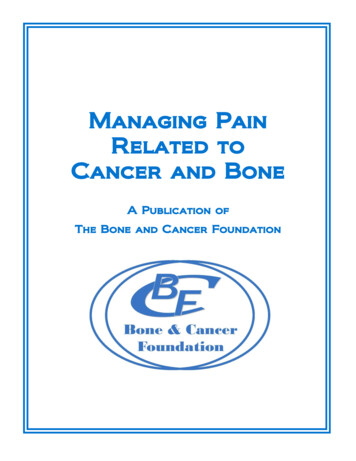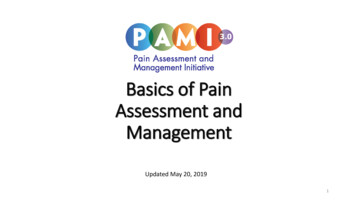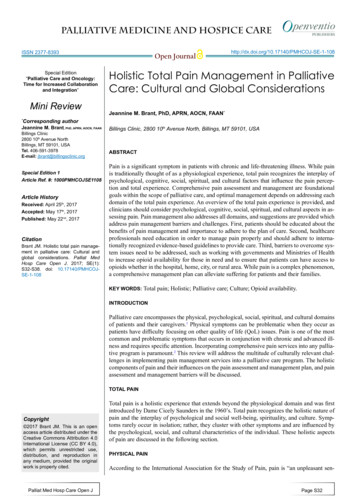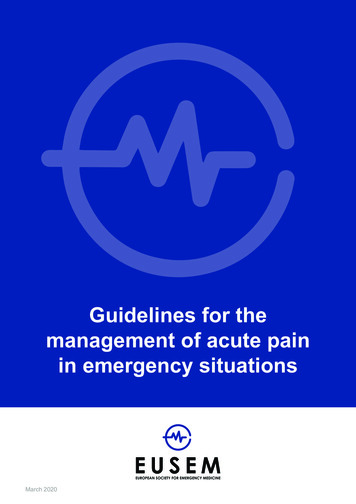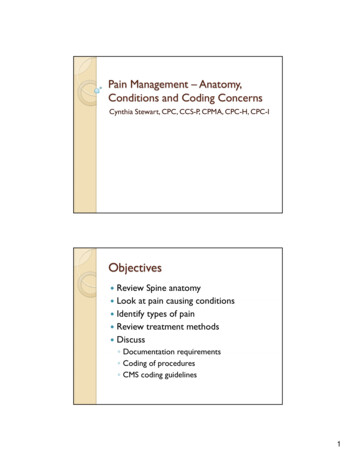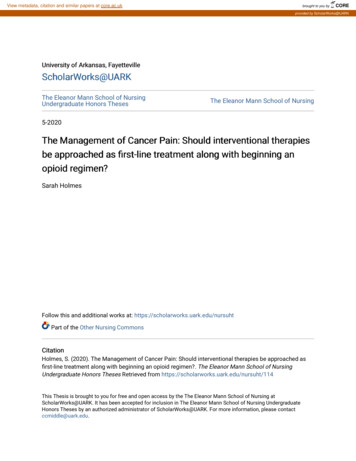
Transcription
View metadata, citation and similar papers at core.ac.ukbrought to you byCOREprovided by ScholarWorks@UARKUniversity of Arkansas, FayettevilleScholarWorks@UARKThe Eleanor Mann School of NursingUndergraduate Honors ThesesThe Eleanor Mann School of Nursing5-2020The Management of Cancer Pain: Should interventional therapiesbe approached as first-line treatment along with beginning anopioid regimen?Sarah HolmesFollow this and additional works at: https://scholarworks.uark.edu/nursuhtPart of the Other Nursing CommonsCitationHolmes, S. (2020). The Management of Cancer Pain: Should interventional therapies be approached asfirst-line treatment along with beginning an opioid regimen?. The Eleanor Mann School of NursingUndergraduate Honors Theses Retrieved from https://scholarworks.uark.edu/nursuht/114This Thesis is brought to you for free and open access by the The Eleanor Mann School of Nursing atScholarWorks@UARK. It has been accepted for inclusion in The Eleanor Mann School of Nursing UndergraduateHonors Theses by an authorized administrator of ScholarWorks@UARK. For more information, please contactccmiddle@uark.edu.
0The Management of Cancer Pain: Should interventional therapies be approached as first-linetreatment along with beginning an opioid regimen?Sarah HolmesUniversity of Arkansas
Review of Literature1IntroductionHaving active cancer pain has the potential to take a toll on a person’s life in the worstways. Sometimes their whole way of living must change while they try to adapt to the pain. It isprojected that there will be 1,806,590 new cancer cases in 2020 with a death rate of 606,520(Jemal, 2020). The cost for treatments for these types of patients can go up to as much as 400,000 per year with one drug costing almost 12,000 per year (Rimer, 2018). Statistics showthat 33-59% of cancer patients experience pain (Dhingra, 2019). There is a cancer painassessment that will be routinely performed for these types of patients in order to give them atherapeutic treatment plan. A pain scale that is currently used in combination with objective dataoften refers to a numerical scale from 0-10, 10 indicating the worst pain and 0 indicating no pain(Aono, 2020). Opioids are the first-line treatment for patients with cancer pain for their safety,flexibility, through dose titration, opioid rotation, by having multiple routes of administration,and effectiveness. Even so, there are many adverse effects, such as constipation, somnolence,and mental clouding resulting from the use of opioids, which may end up in a change of therapyfor many patients (Ahmed, 2020). The next step in treatment after trying opioid andpharmacologic therapy is interventional therapy. There are many options for this approach intreatment, which also have great results. Some examples of these interventional therapies includenerve blocks, a kyphoplasty, a vertebroplasty, and joint injections (Copenhaver, 2019). Casestudies show that the options for interventional therapies are very effective resulting in painrelief. For example, there is a 2017 explaining how 6 patients received joint injections because oftumors causing pain. The pain relief from these injections lasted about eight months with adecrease in the use of opioids as well (Gulati, 2016). Because of the positive results from the
Review of Literature2interventional therapies, perhaps this line of treatment should be suggested as first-line alongwith opioid treatment, giving patients more options and advocacy for their plan of care.Review of LiteratureCancer produces many symptoms, and pain is one of them. When a person is having paindue to cancer, many aspects of the person’s life may be altered or inhibited; for example,activities of daily living may be difficult to perform, their psychological state may be altered,their social lives may be changed, and their overall physical function may be affected in a waythat the person may need to modify what they typically do in a normal day. The pain a personexperiences depends on the type of cancer, how far the cancer has progressed, and the treatmentbeing performed. Statistics show that 33-59% of people who are undergoing cancer treatmentexperience chronic pain and increases to 64-74% in people with more advanced diseases(Dhingra, 2019). Because cancer results in a high prevalence of reported pain, patients should beroutinely screened for pain through a cancer pain assessment.Because cancer pain is such a complex symptom of cancer, the cancer pain assessmentshould be an in-depth evaluation resulting in a specialized plan of care. The first step of thisevaluation starts with a comprehensive assessment of their pain history, the cancer they currentlyhave that is causing the pain, and the treatment they are receiving. One important aspect to assessis their psychosocial status along with their physical functioning status because, as previouslystated, pain may alter these aspects of a person’s life. A comprehensive physical exam andassessment of the pain location should be completed in addition to receiving a description of thepain from the patient. “The description of the pain must include the intensity, temporal features,location and patterns of radiation, quality, and factors that provoke or relieve the pain” (Dhingra,
Review of Literature32019). All of these things including the data received from imaging and other tests incombination help the professional medical team to determine the etiology and pathophysiologyof the pain being experienced. In addition to the objective data, a numerical pain scale is used todetermine the severity of the pain. The pain scale starts at 0 and goes to 10, 0 referring to no painand 10 referring to the worst pain (Aono, 2020). After this is all retrieved, a diagnosis may bedetermined, and a plan of care is then formed in order to relieve the pain.The goal of treatment is to maximize the functioning of the person while decreasing thepossibility or presence of adverse effects occurring with the treatment being given. Routinecancer pain assessments are important because it allows the clinicians and practitioners to see theresponse to the treatment and find new targets for pain treatment. The pain being experiencedmay be reversible; however, persistent and chronic pain will most likely not be completelyeradicated. “Persistent pain is defined as pain that continues beyond the expected time of healing,or for at least three to six months” (Galicia-Castillo, 2019). The goals must be realistic, which iswhy optimal functioning is a great goal to strive towards. Statistics show that there is a sufficientamount of pain relief in 70-90% of patients who abide by the treatment plan of care (Ahmed,2019). Even with these statistics, there are cancer pain patients who are being undertreated ortheir goals are not being reached. In 2014, there was a systematic review performed that resultedin a decrease in 25% of undertreated patients between the years 2008 and 2013; however, thereare still one-third of patients with cancer pain who are still being undertreated. There are manyadverse effects on a person’s life when they are being undertreated, such as a poor ability to copewith the illness, dysfunction with activities of daily living, hardships with physical and sociallife, readmissions into the hospital, and interreference with chemotherapy and radiation
Review of Literature4treatments. This is another reason why it is important for cancer pain reassessments, whichwould aid in the redirection of treatment to a more effective plan of care.The World Health Organization (WHO) analgesic ladder approach was published in themid- 1980s, which gave clinicians and practitioners a stepwise or stepped care approach tostrategize a therapeutic response from treatment depending on the description of the pain,ranking it from mild to severe. The ladder highlights opioids being prescribed for moderate tosevere pain, along with suggesting combination therapy throughout and adjuvant analgesics.“Adjuvant analgesics (or coanalgesics) stands for any drug with a major clinical use other thanpain that is used as an analgesic in selected circumstances” (Ahmed, 2019). The patient thatdescribes their pain as moderate should be prescribed Acetaminophen or an NSAID initially.These analgesics may be combined with adjuvant drugs for additional analgesia, such as ananalgesic antidepressant. The adjuvant drug may also be used to treat other adverse effects orother symptoms from the cancer pain. The ladder also emphasizes that patients with moderate tosevere cancer pain or chronic pain should be treated with an opioid or if the NSAIDs are notreaching a therapeutic range. As previously stated, these drugs may also be paired with adjuvantanalgesics. With the stepped care approach in older adults, the overall idea is that systemicmedications are used later in treatment, or as the pain worsens, because of the potential fortoxicity, adverse effects, and interactions with other prescribed medication. Interventionaltherapies should also be explored firsthand, and surgical intervention should be explored once adisease has progressed to a persistent pain state. There are also times when chemotherapy isgiven palliatively to treat pain as pancreatic cancer patients have a lot of pain. Chemo has thepotential to shrink the tumor enough to hopefully alleviate some of the pain.
Review of Literature5The use for opioid therapy is considered the first-line approach for cancer pain patientswith moderate to severe pain, as shown by the WHO analgesic ladder. Opioids are a commontherapy for cancer pain patients because of the safety with this therapy related to dose titration,the variety of routes used for administration, reliability, and effectiveness for many differenttypes of pain (Ahmed, 2019). Opioids bind to many different kinds of receptors throughout thebody, including in the peripheral and central nervous system. The most analgesic-producingreceptors are the Mu receptors, which are what most opioids are targeted to bind to for highestrate of effectiveness. Chronic cancer pain is typically treated with a long-term treatment of pureMu receptor agonists (Ahmed, 2019). Some examples of Mu receptor agonists are morphine,hydromorphone, oxycodone, oxymorphone, fentanyl, and methadone. Statistics show thatchronic cancer pain is reported by about 30-50% of patients along with 75-90% of patients withother advanced diseases – these reports justify an opioid treatment plan (Ahmed, 2019).The United States has assigned opioids as controlled substances under the ControlledSubstances Act. This federal law places controlled substances under a list ranking the drugs fromschedules of one to five based on the ability of the drugs to be abused – most opioids for cancerpain are schedule II, which would indicate a higher ability to abuse the drug. The government
Review of Literature6has also taken steps to further prevent abuse and overdose from happening through two moreopioid-regulating strategies. Through the Risk Evaluation and Mitigation Strategy (REMS), thereare regulations on extended-release and long-acting opioids in addition to another regulation ontransmucosal immediate-release fentanyl (TIRF) formulations (Ahmed, 2019). Because of this,the undergoing of opioid therapy must be performed with caution while having the patient onthis therapy closely monitored with routine reassessments. Even so, there are clinicians andpractitioners who are concerned about prescribing opioids because of these laws, which couldpotentially lead to the already spoken about undertreatment of pain. There are some questionsthat should be asked when starting a patient on an opioid regimen: “Is there an alternativetherapy that is likely to have an equivalent or better therapeutic index for pain control, functionalrestoration, and improvement in quality of life?; Does the patient have medical problems thatmay increase the risk of opioid-related adverse effects?; Is the patient likely to manage the opioidtherapy responsibility or relevant caregiver likely to responsibly co-manage? (Galicia-Castillo,2019).” These are things to consider for the patient before starting an opioid treatment planbecause of the numerous amounts of side effects and the potential to abuse the drugs.There are many potential side effects or adverse effects from a plan of care involvingopioid therapy for cancer pain. The use of opioids in general increases the risk of abuse oraddiction without the proper monitoring and prescribing. Opioids work by activating thedopamine reward pathways in the brain that can release a euphoria effect, which makes the drugseasier to result in addiction and abuse (Ahmed, 2019). This abuse is not completely uncommonin patients with cancer pain, as a study of 432 patients with cancer pain using opioids forpalliative care showed that 18% of these patients were using the opioids out of their prescribedplan of care to cope with the illness (Ahmed, 2019). The incorrect use of opioids for cancer pain
Review of Literature7may interfere with the effectiveness of the treatment they are receiving. Even so, overdoses andhospitalizations for cancer pain related opioid use are uncommon. With the patients being closelymonitored and reassessed, a risk assessment should also be performed to ensure the patient’ssafety: observe for a personal history of alcohol or drug abuse, family history of alcohol or drugabuse, and a major psychiatric disorder. Encouragement of the patient to adhere to the plan ofcare is crucial for their safety along with limiting the quantity of drugs used and no early refills.Pain contracts should be used in combination with drug screening to ensure the medications arebeing taken.The most common side effects from opioids include gastrointestinal (GI) andneurological issues. Opioids are typically known for their GI effects, such as constipation. Thecause of this is most commonly decreased activity of the GI tract, or decreased peristalsis. Thereare other results from this as well, such as nausea, pain, and bloating. In cancer patient usingopioid therapy, rates of constipation are around 60-90% (Ahmed, 2020). Narcotic bowelsyndrome is a term that can be used when the pain is significant in the abdomen with increasingthe use of opioids. This is a paradoxical effect because the pain is worsening with opioid useeven though opioids are a type of analgesic medication.The other most common side effect is the neurological issues involving somnolenceand/or mental clouding. These issues are typically at their worst when initiating opioid therapy orincreasing the dose of the drug being used. The clinical manifestations vary depending on theperson but can be shown in various degrees of inattention or fatigue, disorientation, severememory impairment, or extreme confusion and delirium (Ahmed, 2020). There was a crosssectional study performed involving 1915 patients with cancer who were beginning their opioidtherapy treatment plan and had been taking opioids for at least three days. The study recorded the
Review of Literature8degree of cognitive impairment based on the Mini-Mental Status Examination (MMSE). Theresults indicated that one-third of the population had scores less than 27, indicating slightcognitive dysfunction (Ahmed, 2020).As previously stated, there are many side effects resulting from the use of opioids forcancer pain management; however, there are side effects that are not as common as others.Nausea and vomiting may occur at the initiation of the opioid therapy but does not persistbecause of the tolerance effect opioids can. A sign of neurotoxicity is myoclonus, which is theuncontrollable spasming of muscles. This is a sign that the dose is too high and is oftenaccompanied by somnolence and mental clouding. In addition, there may be a decrease in sexhormones because opioids affect the hypothalamic-pituitary-adrenal axis. Some respiratoryissues involve an opioid-induced sleep-disordered breathing, which would be caused by someonealready having sleep apnea, and respiratory depression, which rarely happens even though it iscommonly considered to be a serious adverse effect. In a systematic review and meta-analysis,there were reports of 91% of patients having sleep disordered breathing receiving opioids insleep clinics and 63% of patients in pain clinics (Arif, 2020). Because of these statistics, thesepatients should be closely monitored. Pruritus is seen in about 2-10% of patients receiving opioidtherapy along with the rare account of an allergic reaction. Urinary retention is a possibilitybecause the opioids attach to a receptor that may result in total bladder relaxation. Infection riskhas been shown by four different epidemiologic studies to be a side effect of opioids becausesome of them have immunosuppressive qualities. Finally, opioid induced hyperalgesia can occur,which is also a paradoxical response that is shown by a patient receiving opioids becoming moresensitive to some types of painful stimuli, or in extreme cases, experience pain from stimuli thattypically would not be painful, or allodynia (Ahmed, 2020).
Review of Literature9There are many things to consider when prescribing opioids to a patient with cancer pain.Each person is different, so every person will respond differently to the opioid treatment plan.This also includes each person’s reaction to the adverse effects that go along with this kind oftreatment, which may be because of many personal characteristics, such as age, genetics, otherdrugs they might be on, and comorbidities (Ahmed, 2020). There should also be considerationbased on their social and psychological factors, such as depression, anxiety, coping skills,support, and financial status. Two comorbidities that are of great importance include renalinsufficiency and liver failure. Because some opioids result in active metabolites accumulatingthen being excreted by the renal system, this would be unsafe for a patient with renalinsufficiency because of side effects and potentially toxicity. Because most opioids aremetabolized by the liver, patients with liver failure would be at risk for side effects (Ahmed,2020). Other comorbidities to look out for include obesity, sleep disturbances, such as sleepapnea, dementia or any type of cognitive impairments, history of falls and uneasy gait,hypertension, congestive heart failure, and constipation.As there are many risks to starting an opioid regimen for cancer pain, there are also manybenefits. One benefit to the opioid plan of care is that there are numerous routes ofadministration, the favored routes being oral, transdermal, subcutaneous, intravenous,intrathecal, and intraspinal. The oral route is deemed the easiest by patients because there isflexibility to it and is extremely convenient (Ahmed, 2020). The transdermal route is often usedfor the use of chronic pain and may be favored over the oral route due to the GI effects caused bydigestion of the medication, such as constipation; however, the patient must contain enoughadipose tissue for the transdermal route to result in therapeutic treatment. The subcutaneous andintravenous routes are typically only temporary, and these regimens begin when other routes
Review of Literature10need to be switched for a period of time. Finally, the intrathecal and intraspinal routes have beenshown to be extremely effective in the controlling of the cancer pain and produce fewer sideeffects (Ahmed, 2019).As previously stated, each person with an opioid regimen will respond to each drug in adifferent and nonpredictable way. This is very much involved in dose titration, which is anotherbenefit of an opioid regimen. Each regimen is individualized, based on needs and desiredoutcomes for each patient. The goal of dose titration is to have a therapeutic analgesic responsewith the fewest side effects possible; however, that is not always the case. The dose will beincreased until the person experiences the analgesia with side effects or until the side effectsbecome unbearable for the patient. During the dose titration process, each patient is monitoredextremely closely for side effects and especially toxicity. If a dose becomes extremely high, therewill be a reassessment to make sure that specific drug is still beneficial for the patient and theirtreatment plan (Ahmed, 2019). Even so, cancer patients typically do not have extremely highdoses.There is a point in dose titration where a patient may be deemed poorly responsive to theopioid regimen because of side effects or the benefits no longer outweigh the adverse effects,which could lead to multiple options being explored to reach analgesia. There could be a trial ofanother opioid being used, direct management of the side effects, or adding other therapies to theequation, such as nonopioids, adjuvant analgesics, or nonpharmacologic therapy. The action oftrying a different opioid rather than the one being used previously is called opioid rotation(Ahmed, 2019). This is a great option for when a patient responds poorly to another opioid. Theidea and goal of this action is to provide a balance between analgesia and side effects, whichwould be another benefit to an opioid regimen – it is flexible. Another aspect to this idea of
Review of Literature11being poorly responsive to a regimen, is that a person could potentially become tolerant to theadverse effects of the drugs over a few weeks of treatment (Ahmed, 2019). Even so, if the patientwere to switch to another drug during a time of opioid rotation, the new opioid could have evenstronger effects, which might not be worth the waiting time for tolerance to begin.There is an analysis of Cochrane reviews (152 studies, including 13,524 patients) thatresulted in 19 out of every 20 people with the description of pain being moderate to severecancer pain on an opioid regimen should have had their pain reduced to mild or moderate or nopain within fourteen days. Most of the patients experienced adverse effects, and one to two ofevery ten patients being treated would find these adverse effects intolerable, leading to a changein treatment (Ahmed, 2019). Even so, the studies included small group settings for review andfew follow-up meetings with the patients, so the level evidence is not very high.Patients who do not tolerate first-line treatments, such as opioids, should exploreinterventional therapies. Interventional refers to therapies that are invasive with the goal ofanalgesia with many options, such as injection therapies, spine-related injections,vertebroplasties and kyphoplasties, neural blockades, neuraxial infusions, intrathecal catheterplacement, and intraventricular opioid delivery. These approaches are oriented towards givingsafe and effective pain relief. The idea of interventional therapy is used when the benefits nolonger outweigh the risks for pharmacotherapy. Although the effects tend to be positive, becausethey are invasive, they automatically increase the risk for infection.Cancer pain patients have effective options to attempt with the goal of effective painrelief. Soft tissue and joint injections are a great option for cancer pain patients as long as thereare no contraindications for injections, such as coagulopathy, leukopenia, pneumothorax, orinfection. One of the benefits to this type of interventional therapy is that the pain from the
Review of Literature12injection is relieved for days or even weeks. Another type of interventional therapy is the spinerelated injection, which are typically for acute and chronic, non-cancer, low back and neck painbut can also be useful for patients with cancer pain involving other approaches including epiduralsteroid injections, facet joint injections, facet denervation approaches, and sacroiliac injections.One 2017 case study consisting of 6 patients each receiving joint injections because of sacroiliactumors causing pain. Pain scales were recorded before and after the procedures, resulting in asignificant pain improvement that lasted for about eight months for each person. In addition,each person decreased their use of opioids because of their pain relief from the procedure(Gulati, 2016).Other options for interventional therapies include a vertebroplasty and kyphoplasty.Vertebroplasties involved the injection of a medical cement into a vertebral body known as acompression fracture in order to stabilize the spine. Kyphoplasties involves something called a“inflatable bone tamps,” which is basically a balloon that is inflated and releases the pressurefrom the collapsed vertebral body creating an area where cement may be injected like thevertebroplasty (Copenhaver, 2019). There is a 2016 case study performed on 158 patients with228 cancer-related vertebral compression fractures who had chosen to do the kyphoplasty. Theresults were recorded right after the procedure and three months after. The result of the studyconcluded a decreased mean pain score from 7.5 to 3.6 with a decreased disability index from 50to 42. Cement leaks are a rare complication; however, in this study, there was a result of 31%(Hargunani, 2016). The results showed that pain was relieved and controlled in over one-half ofthe patients, which also resulted in a decrease in medications for pain management and paindisability scores. In addition, the kyphoplasty procedures resulted in the decreased need formedications of any kind, walking aids, such as canes and braces, and a decreased prevalence for
Review of Literature13bedrest (Copenhaver, 2019). The benefits from these procedures are strong; however, there arestill some complications and things to take account for, such as a pulmonary embolism, spinalcord compression, and paraplegia. Even so, the risk of these adverse effects happening isrelatively low.The next interventional therapy that will be discussed are neural blockades. Theprocedure of nerve block injections includes injecting a drug within close proximity of a nerve inhopes for a result of pain relief. Therapeutic nerve blocks are providing pain relief for a longerperiod of time. Nerve blocks can be divided into a neurolytic procedure or a nonneurolyticprocedure (Copenhaver, 2019). A neurolytic procedure involves the alteration of a nerve,potentially permanently injuring it. A nonneurolytic procedure involves preserving the nervewith no injury. The experience with these types of procedures for cancer pain has shown to bebeneficial through the recording of case reports and other clinicians and practitioners. Yes, theseprocedures are beneficial; however, nerve blocks should not be considered until all other optionshave been explored. This is because of the risk of neuritis, which is a type of nerve pain, thepossibility of some type of neurological compromise, tissue damage resulting from the neurolyticprocedures, and insufficient reach of therapeutic levels of analgesia (Copenhaver, 2019). There isa block, though, that is safe and effective and used routinely for cancer pain patients when theirfirst-line therapy with medication does not suffice. This blockade is called the Celiac PlexusNeurolysis (CPN), which is commonly used for pain occurring because of some type ofabdominal cancer, typically pancreatic cancer (Copenhaver, 2019). For neurolytic blockades ingeneral, there are many risks that are involved with the procedures. For example, there could bea result of some type of autonomic dysfunction, bladder and/or bowel dysfunction, orthostatichypotension, neuritis, and anesthesia.
Review of Literature14One interventional therapy that includes targeted drug delivery is neuraxial infusion. Thistype of drug therapy involves using a neuraxial space, such as an epidural space and intrathecalspace. There are multiple options for the infusion of this drug therapy, such as different infusiondevices along with different drugs available. This treatment is optimal for cancer pain patientsbecause the pain is targeted and has a high potential for the relief of this pain. Even so, the risksand benefits need to be weighed. One type of neuraxial infusion that has been very successful isthe intrathecal drug delivery. This therapy involves the same targeted therapy as stated beforeand is typically used for cancer pain patients. The final type of neuraxial infusion discussed is theintraventricular opioid therapy, which involves a drug being injected into the cerebral ventriclesin the brain through an infusion device. The evidence proving this therapy is greater than opioidtherapy is extremely weak; however, the experience from the procedure has shown 50-90% ofcancer pain patients have strong pain relief (Copenhaver, 2019).There was a case study performed recording the beneficial aspects of using intrathecaldrug delivery. The case study involved a randomized trial consisting of 202 patients with cancerpain that was not being managed and treated in the most efficient way. The pain was notcontrolled. The requirement for the patients to receive the intrathecal drug delivery was that theyhad to tolerate intrathecal morphine administration over a four-week assessment. The otheroption for the patients was a conventional medical management therapy, which involved anytherapy other than spinally administered medication. Both groups increased cancer pain relief,however, there was a greater than 20% difference in the intrathecal group with the most painrelief. They also reported a decrease in toxicity from 58% to 38%. There were also decreasedamounts of side effects resulting from the intrathecal therapy along with a longer survival period
Review of Literature15being about six months longer. There was a six month follow up after the study was performed,and the results remained the same (Copenhaver, 2019).ConclusionOverall, opioid therapy treatment has been effective, even though there are many possibleadverse effects. Because the adverse effects can be so prominent, patie
The Eleanor Mann School of Nursing Undergraduate Honors Theses The Eleanor Mann School of Nursing 5-2020 The Management of Cancer Pain: Should interventional therapies be approached as first-line treatment along with beginning an opioid regimen? Sarah Holmes Follow this and additional works at: https://scholarworks.uark.edu/nursuht




